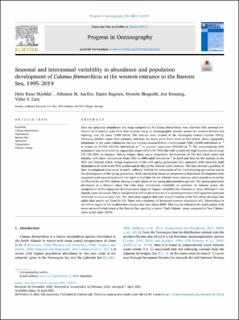| dc.description.abstract | Data on copepodid abundance and stage composition of Calanus finmarchicus was collected with seasonal resolution (5–6 times a year) from four stations along an oceanographic transect across the western Barents Sea Opening over 25 years (1995–2019). The stations were located in the Norwegian Coastal Current (NCC), inflowing Atlantic water (two stations), and near the Arctic polar front south of Bear Island. Mean copepodite abundance in the water column for the four stations increased from a level around 1000–10,000 individuals m−2 in winter to 30,000–100,000 individuals m−2 in summer (maximum 670,000 m−2). The overwintering (G0) population was dominated by copepodite stage 5 (CV) (40–70%) but with a relatively high fraction also of stage CIV (25–35%) in January. During winter, there was a progressive development of CVs into adult males and females, with mean abundances from 1500 to 4000 adult females m−2 in April and May for the stations in the NCC and Atlantic water. Young copepodids of the new spring generation (G1) appeared with relatively high abundances in April at the NCC station and in May at the Atlantic water stations. The data showed a gradient of later development from south to north, reflected both in the maturation of the overwintering generation and in the development of the spring generation. Back-calculations based on temperature-dependent development time suggested peak spawning around late April to mid-May for the Atlantic water stations, and a month or so earlier (in March) for the NCC station, during an early phase of the spring phytoplankton growth. The spring generation developed as a distinct cohort but with large interannual variability in numbers. In Atlantic water, the composition of the copepodid developmental stages in August resembled the situation in June, although it was slightly more advanced. This is interpreted to reflect development of a second generation (G2) spawned upstream sometime in June or early July. The June data suggests that only a small fraction of the G1 cohort develops into adults that spawn and form the G2. There was a tendency of increased summer abundance of C. finmarchicus in the inflow region of the southwestern Barents Sea after about 2005. This may be related to the wind regime with more eastward wind-stress at the Barents Sea opening in recent ‘high Calanus’ years compared to ‘low Calanus’ years in the early 2000s. | en_US |
